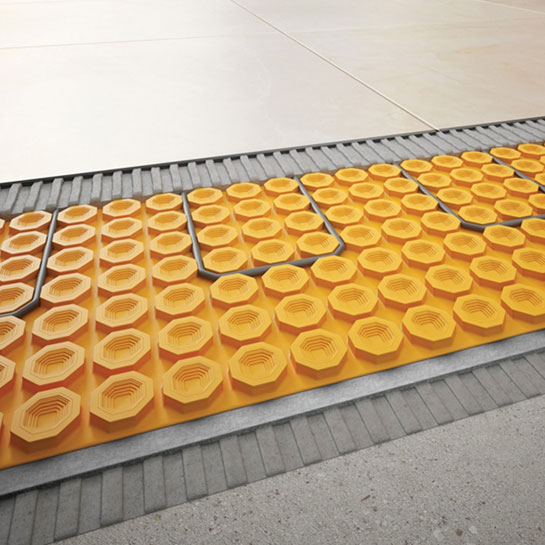There are many different heating systems on the market. Among these, underfloor heating is becoming more and more common in newly built homes and those undergoing major renovation.
But what exactly is underfloor heating, what advantages does it offer and how does it work? In ParaTuReforma we will answer these and other questions to help you find out if it is the air conditioning system that your home needs.
Underfloor heating: what is it?
The underfloor heating is a very interesting and original type of home heating. This is mainly because it does not heat the air inside the building, but emits thermal radiation that raises the temperature of the floor.
Obviously, there are variants that can also be installed on walls and ceilings. One of its advantages is that the elements that make up the installation are completely hidden under the pavement, but this system has other interesting benefits.

Advantages of underfloor heating
There is no doubt that radiant flooring offers a wide range of advantages. Let’s take a look at them:
- Reduced energy consumption. It is a low-temperature system that can generate enough heat to heat the home from aerothermal or geothermal appliances, condensing boilers or solar panels. Therefore, it can be qualified as an efficient and economical technology.
- It leaves nothing in sight. As we said before, all the elements of the system are hidden under the flooring, so there is no need to look for space for radiators, convectors or fireplaces, for example.
- It can also cool. To understand this, you need to know how this technology works. However, we can tell you in advance that it is possible to reduce the temperature of the house in summer by circulating cold water through its pipes.
- Greater sensation of comfort. This system does not have the traditional disadvantages of the most common heating systems, so it does not dry out the air and distributes the heat evenly over the entire surface.
However, we cannot forget that it also has some drawbacks, such as its high price (about 50 euros per square meter), the complexity of the installation or the high inertia involved. By this we mean that it is only recommended in spaces that have constant heating needs.
How they work and how they are installed
In this section we will explain how radiant floors work and how they are installed.
Operation
The mechanism used in underfloor heating is based on a network of plastic pipes installed under the pavement and covered with a layer of mortar. Subsequently, hot water in summer or cold water in winter is circulated through it.
When this happens, the heat or cold given off by the pipe heats or cools the floor and the air in the lower part of the room, resulting in greater thermal comfort.
Surface preparation
The first step is to clean the surface of the slab and then check that it is level and uniform. To do this, it is essential to remove the previous flooring and the mortar used to fix it.
Collectors
Once the previous step has been carried out, it is time to install the collectors. These will be the points where the water comes together before it is introduced into the system and after it has been used.
But where should the collectors be mounted? Experts indicate that the most suitable place is on the wall. In addition, it is advisable to place them at mid-height and hide them inside a built-in cabinet so that they do not spoil the aesthetics of the room.
Insulating panels
It is important to note that the choice of the insulating panel will depend on the characteristics of the house. If its insulation level is good or excellent, you will be able to choose a cheaper model. On the other hand, if it is deficient, you will have to opt for a higher quality one. If you don’t, the energy consumption of the system could skyrocket.
In any case, once you have chosen the right one, you will have to install it on the slab of the house. Special attention must be paid to the joints, as they must be perfectly sealed to avoid thermal bridges when laying the mortar.
Pipe
After placing the insulating panels, it is time to place the plastic pipe netting. This has to be fastened to its nipples or, failing that, use the self-fixing systems included.
It is also vitally important to connect the pipes to and from their corresponding outlets in the manifold in the correct way. The ideal is to avoid splices that, in the long run, may cause leaks.
Filling and pressure test
Simply start up the system, allow water to enter the circuit and check that there are no leaks.
Finishing and flooring
Once you have verified that there are no leaks, it is time to pour the mortar over the pipe. Remember that it must be at least 5 centimeters thick. Depending on the model chosen, you will have to wait a certain amount of time for it to set. Generally, 48 hours is sufficient.
After the mortar has set, you can start laying the flooring to give the room an aesthetic finish. You can opt for imitation wood, hydraulic or any other type of coating, as the results are always excellent.
Undoubtedly, radiant floors occupy a privileged place among the most popular heating systems today. The reasons? Mainly, their functionality, simplicity of operation and high energy efficiency. We are almost sure that, after reading this article, you have become a little more convinced to install this system in your home. If so, please contact our customer service team. We will help you choose the right one for you and offer you a free quote.


